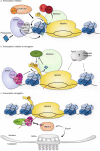Dynamic modules of the coactivator SAGA in eukaryotic transcription
- PMID: 32616828
- PMCID: PMC8080568
- DOI: 10.1038/s12276-020-0463-4
Dynamic modules of the coactivator SAGA in eukaryotic transcription
Abstract
SAGA (Spt-Ada-Gcn5 acetyltransferase) is a highly conserved transcriptional coactivator that consists of four functionally independent modules. Its two distinct enzymatic activities, histone acetylation and deubiquitylation, establish specific epigenetic patterns on chromatin and thereby regulate gene expression. Whereas earlier studies emphasized the importance of SAGA in regulating global transcription, more recent reports have indicated that SAGA is involved in other aspects of gene expression and thus plays a more comprehensive role in regulating the overall process. Here, we discuss recent structural and functional studies of each SAGA module and compare the subunit compositions of SAGA with related complexes in yeast and metazoans. We discuss the regulatory role of the SAGA deubiquitylating module (DUBm) in mRNA surveillance and export, and in transcription initiation and elongation. The findings suggest that SAGA plays numerous roles in multiple stages of transcription. Further, we describe how SAGA is related to human disease. Overall, in this report, we illustrate the newly revealed understanding of SAGA in transcription regulation and disease implications for fine-tuning gene expression.
Conflict of interest statement
The authors declare that they have no conflict of interest.
Figures


Similar articles
-
Subunits of ADA-two-A-containing (ATAC) or Spt-Ada-Gcn5-acetyltrasferase (SAGA) Coactivator Complexes Enhance the Acetyltransferase Activity of GCN5.J Biol Chem. 2015 Nov 27;290(48):28997-9009. doi: 10.1074/jbc.M115.668533. Epub 2015 Oct 14. J Biol Chem. 2015. PMID: 26468280 Free PMC article.
-
Insights into SAGA function during gene expression.EMBO Rep. 2009 Aug;10(8):843-50. doi: 10.1038/embor.2009.168. Epub 2009 Jul 17. EMBO Rep. 2009. PMID: 19609321 Free PMC article. Review.
-
Transcription and mRNA export machineries SAGA and TREX-2 maintain monoubiquitinated H2B balance required for DNA repair.J Cell Biol. 2018 Oct 1;217(10):3382-3397. doi: 10.1083/jcb.201803074. Epub 2018 Jul 27. J Cell Biol. 2018. PMID: 30054449 Free PMC article.
-
Multifaceted activities of the plant SAGA complex.Biochim Biophys Acta Gene Regul Mech. 2021 Feb;1864(2):194613. doi: 10.1016/j.bbagrm.2020.194613. Epub 2020 Jul 31. Biochim Biophys Acta Gene Regul Mech. 2021. PMID: 32745625 Review.
-
Adenovirus E1A requires the yeast SAGA histone acetyltransferase complex and associates with SAGA components Gcn5 and Tra1.Oncogene. 2002 Feb 21;21(9):1411-22. doi: 10.1038/sj.onc.1205201. Oncogene. 2002. PMID: 11857084
Cited by
-
Transcriptional co-activators: emerging roles in signaling pathways and potential therapeutic targets for diseases.Signal Transduct Target Ther. 2023 Nov 13;8(1):427. doi: 10.1038/s41392-023-01651-w. Signal Transduct Target Ther. 2023. PMID: 37953273 Free PMC article. Review.
-
Accumulation of senescence observed in spinocerebellar ataxia type 7 mouse model.PLoS One. 2022 Oct 17;17(10):e0275580. doi: 10.1371/journal.pone.0275580. eCollection 2022. PLoS One. 2022. PMID: 36251631 Free PMC article.
-
From Genes to Transcripts, a Tightly Regulated Journey in Plasmodium.Front Cell Infect Microbiol. 2020 Dec 17;10:618454. doi: 10.3389/fcimb.2020.618454. eCollection 2020. Front Cell Infect Microbiol. 2020. PMID: 33425787 Free PMC article. Review.
-
A novel ubiquitin-proteasome system regulation of Sgf73/ataxin-7 that maintains the integrity of the coactivator SAGA in orchestrating transcription.Genetics. 2023 Jul 6;224(3):iyad071. doi: 10.1093/genetics/iyad071. Genetics. 2023. PMID: 37075097 Free PMC article.
-
The SAGA complex regulates early steps in transcription via its deubiquitylase module subunit USP22.EMBO J. 2021 Aug 16;40(16):e102509. doi: 10.15252/embj.2019102509. Epub 2021 Jun 22. EMBO J. 2021. PMID: 34155658 Free PMC article.
References
-
- Workman JL, Kingston RE. Alteration of nucleosome structure as a mechanism of transcriptional regulation. Annu. Rev. Biochem. 1998;67:545–579. - PubMed
-
- Carrozza MJ, Utley RT, Workman JL, Cote J. The diverse functions of histone acetyltransferase complexes. Trends Genet. 2003;19:321–329. - PubMed
-
- Brownell JE, et al. Tetrahymena histone acetyltransferase A: a homolog to yeast Gcn5p linking histone acetylation to gene activation. Cell. 1996;84:843–851. - PubMed
-
- Grant PA, et al. Yeast Gcn5 functions in two multisubunit complexes to acetylate nucleosomal histones: characterization of an Ada complex and the SAGA (Spt/Ada) complex. Genes Dev. 1997;11:1640–1650. - PubMed
-
- Martinez E, Kundu TK, Fu J, Roeder RG. A human SPT3-TAFII31-GCN5-L acetylase complex distinct from transcription factor IID. J. Biol. Chem. 1998;273:23781–23785. - PubMed
Publication types
MeSH terms
Substances
LinkOut - more resources
Full Text Sources
Molecular Biology Databases
Research Materials

